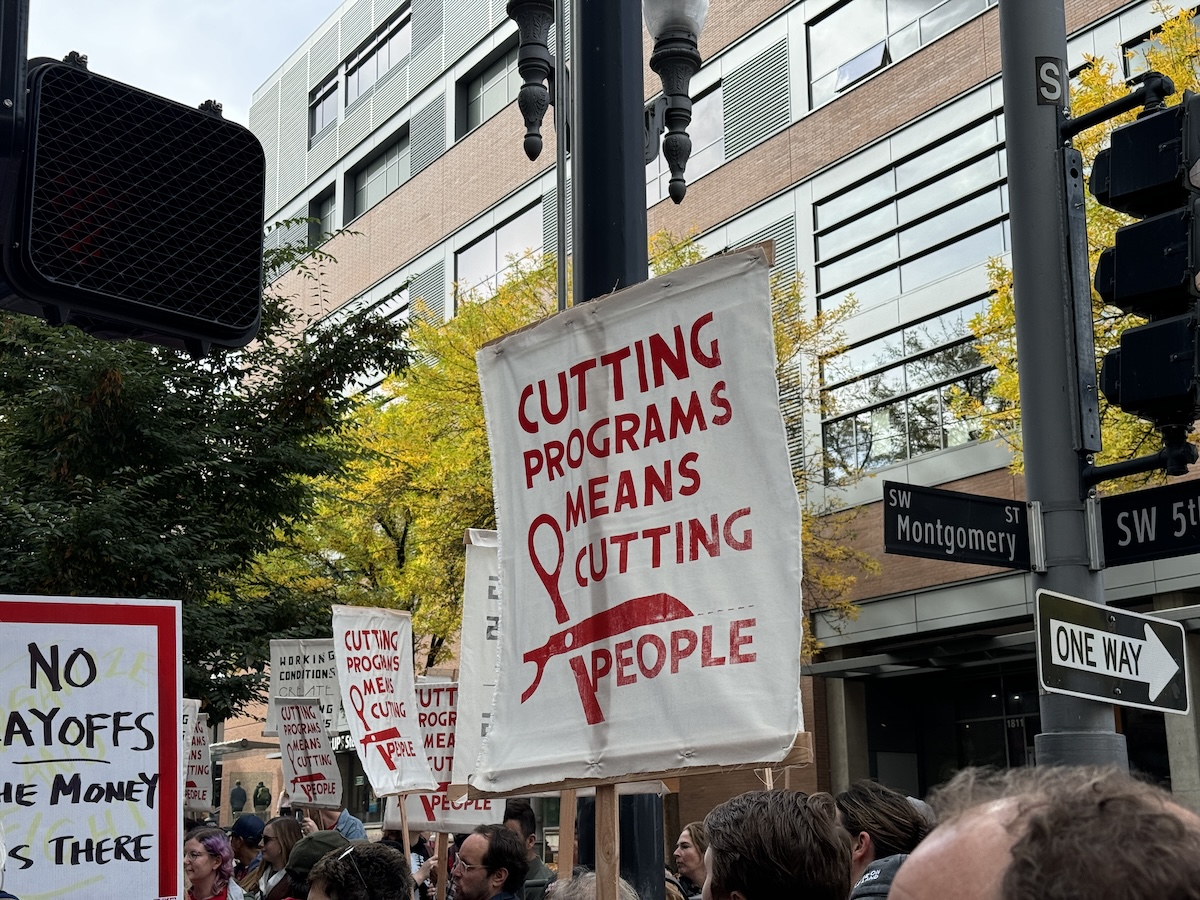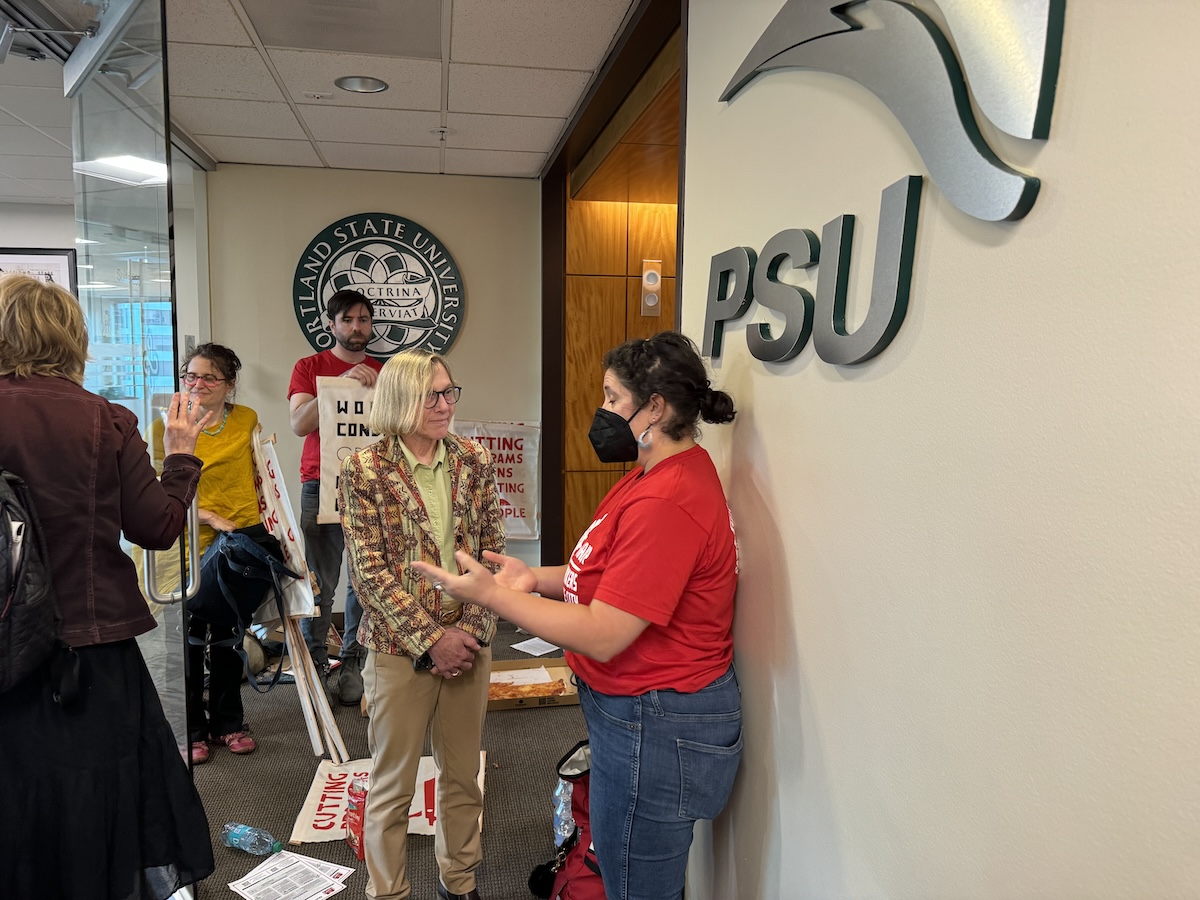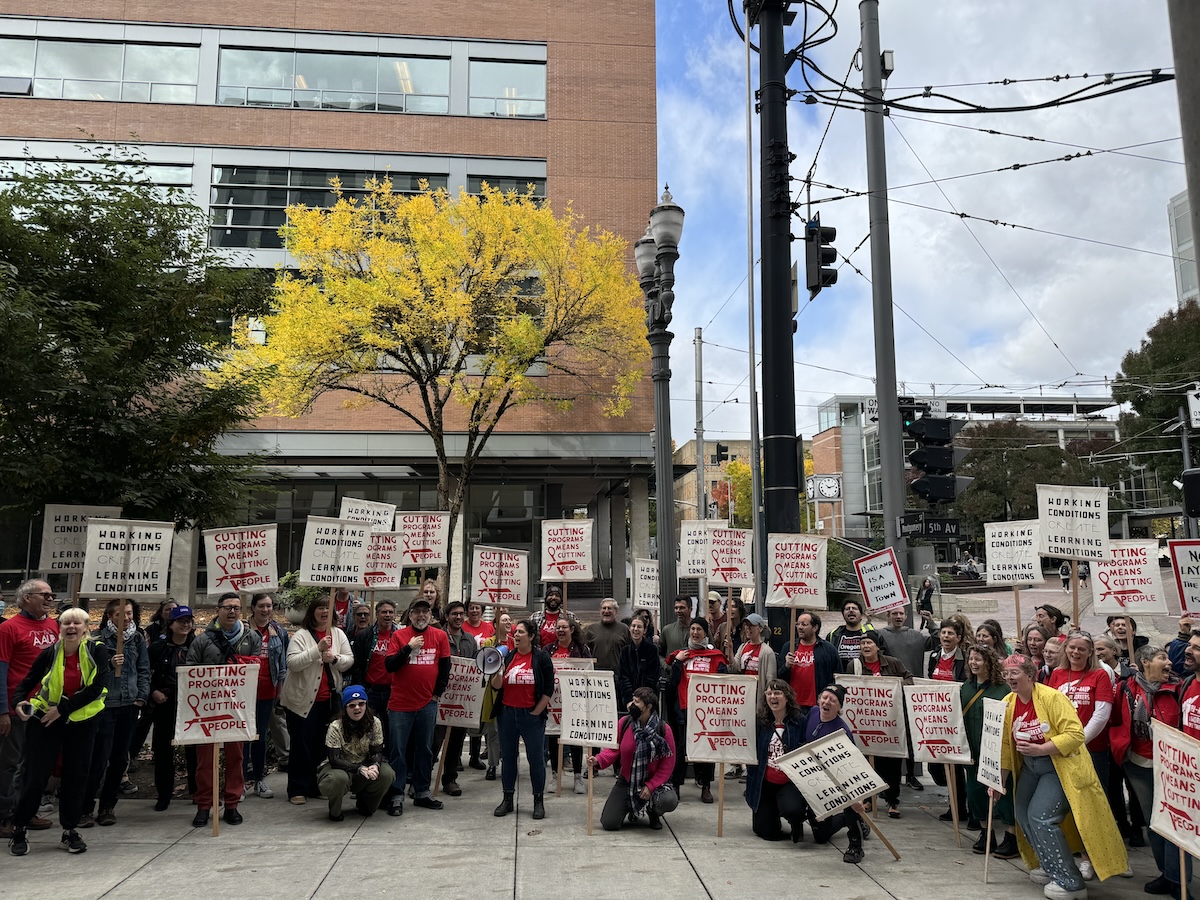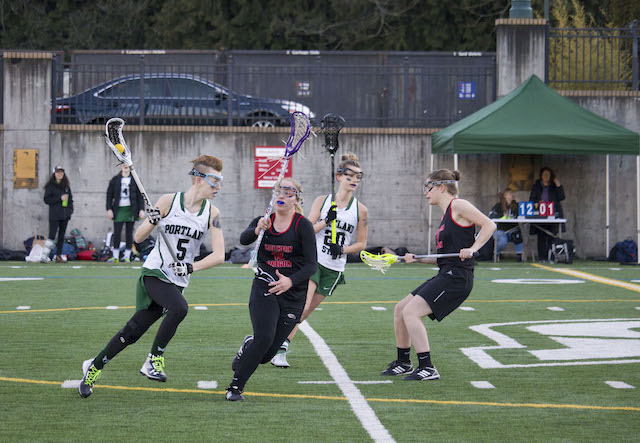Portland State University American Association of University Professors (PSU-AAUP) members donned their red shirts and held up their pickets to march from the Vanport Building to the Neuberger Center on Oct. 17. The center is home to the office of PSU President Ann Cudd, where union members would protest the notices of layoffs which Non-Tenure Track Faculty (NTTF) members had received.
Signs reading “cutting programs means cutting people” and “working conditions create learning conditions” were contrasted with the PSU crest hanging by the president’s office door.
Union leadership demanded to speak with President Cudd, and after hours of waiting, a tense conversation with PSU-AAUP President Emily Ford ensued.
“We came up here today to ask President Cudd to reverse the cuts of nearly 100 of our co-workers who were notified on Tuesday of a layoff,” Ford said. “I asked her to reverse the cuts. I asked her to settle a fair contract now.”
The notice sent out is referred to as a “notice of a notice.” According to one NTTF’s layoff notice, an official notice of termination will be sent on or before Dec. 15. If a termination notice is received, that faculty member’s position will end June 15, 2025. For NTTFs who don’t have continuous appointments, that termination will come on Jan. 1 according to Ford.
When President Cudd was leaving, a union member asked if she would reverse the cuts and settle a fair contract.
“I’m sure we’ll settle a fair contract,” Cudd said.
As the PSU-AAUP’s Nov. 30 contract expiration deadline looms, bargaining is still in full swing between the union and the PSU administration. With approximately 90 hours at the bargaining table, only five tentative agreements have been made according to an email sent out by PSU-AAUP. The PSU-AAUP also released an alternative budget analysis by Howard Bunsis—an Accounting Professor at Eastern Michigan University—that disputes the University’s picture of the budget. These factors along with the layoff notices have inflamed tensions between the union and administration.
“PSU is in a solid financial position. This conclusion is supported by solid bond ratings, which are assigned despite the declines in enrollment, and are supported by solid reserves and annual excess cash flows,” the Bunsis report concluded. “The number and salaries to administration are increasing much larger and faster than salaries for instructional faculty and academic professionals.”
The report also claims that the University is over-accounting for the University pension—the Oregon Public Employees Retirement System (PERS) and Other Post Employment Benefits (OPEB) to the tune of $140 million.
According to the PSU Vice President of Finance and Administration Andria Johnson, this number does not impact PSU’s operating budget at all.
“What he’s talking about is an entry that we do on our financial statements that’s on top of things,” Johnson said. “We do have to pay into PERS but that’s not built into our operating budget. It doesn’t come out of E&G [Education and General funds]. It doesn’t come out of auxiliaries or restrictive funds or anything. It is literally an accounting entry that’s done on the top once all the books are closed.”
The nuances of the budget analysis are complex and dense to someone not familiar with finance. Yet the overall tone of the administration’s view of the budget and PSU-AAUP’s analysis of the budget is readily apprehended.
“I think their budget is pessimistic,” Ford said. “There has not been a year in my 14 years at Portland State University where they’ve said we have to cut and we have no money, and then at the end of the year there’s a surplus. I’ve never seen that.”
Though the Bunsis report paints a more optimistic picture of PSU’s budget, PSU administration was unconvinced of this proposed financial reality.
Johnson explained that Bunsis’ analysis looks at the finances of PSU from an audited financial statement point of view which lumps everything together.
“Based on this information, there’s no budgetary issues,” Johnson said. “However, that’s not how accounting at public universities work. Public universities follow the Governmental Accounting Standards Board for our accounting practices which require us to put things into different funds… they’re segregated for the purpose of carrying on specific activities or attaining certain objectives in accordance with special regulations, restrictions or limitations.”
There are three main categories in which funds fall into PSU’s operating budget. There are Education and General (E&G) funds, non-E&G funds that account for service departments and designated operations and then restricted funds. There also are capital funds—usually coming from the State of Oregon which can only be used on buildings.
“[In] our audited financial statements, they don’t break it up like that,” Johnson said. “All the money gets smushed together so there’s a little bit of discrepancy there because not all funds can be intermingled in that way. We can’t just come in and say we’re going to take this and we’re going to pay this over here with it… Oftentimes when you’re looking at the auditor’s financial statements it’s going to tell you a story that does not necessarily match the story of our operating budget.”
The number looming over the budget discourse is the purported $18 million budget deficit that the University is facing. This is an E&G deficit that arises from two primary causes according to Johnson.
With student enrollment steadily declining and costs continuing to rise, the administration sees the costs as simply outpacing the revenue the University can bring in through tuition and student enrollment.
This along with Oregon Governor Tina Kotek’s spending cap on higher education, the state allocation that had been growing for PSU is coming to a stop. According to Johnson, the University has also benefited from higher education emergency relief funds which helped mask the budget deficit and allow PSU to build its reserves.
One conclusion of the Bunsis report that has sparked outcry is the claim that administrator’s salaries continue to increase at a much faster and larger rate than faculty and academic professionals—whose division is facing $12.5 million in cuts according to an email sent out by PSU-AAUP.
“Bunsis actually refers to institutional management as a pure upper administration,” Johnson said. “That is not the case. He makes this case that administrators’ salaries are growing. Can I tell you what’s in that bucket? Our campus public safety is in that bucket. My budget office is in that bucket… We have people in research and graduate studies that fall under institutional management… So there’s kind of a misnomer about what administration is… It does not necessarily mean that we’re paying people like me, vice presidents and above or deans, a lot more. It means that that category overall is growing.”
The announcement of the new Performing Arts and Culture Center will be built on PSU’s campus. Utilizing $300 million in state bonds hurled PSU’s mission to revitalize downtown to the forefront while faculty were receiving layoff notices.
“The effort is going into concrete and steel, $300 million or so going to the state for bonds to build concrete and steel to revitalize a university that has no faculty left,” Ford said. “That’s not a university.”
According to an emailed statement from Christina Williams, PSU’s Director of Strategic Communications, the figure of $300 million is not accurate.
The University is only asking for $85 million to make up their portion of the project, with the majority of the funding coming from the City of Portland, according to Williams.
In President Cudd’s announcement of this new performing arts center, Cudd noted that the project has no bearing on PSU’s E&G funds—composed of annual academic operations. According to Cudd’s message, the funding for this project is paid for with auxiliary reserves that cannot be used for academic operations.
“It’s what we call a once in a century opportunity, and while the timing is not perfect, if we aren’t engaged now and looking toward the future… we will have missed this opportunity,” Johnson said. “It is something that we can’t just not do and let it go by the wayside.”
According to Johnson, the administration hopes that newer buildings and a revitalized campus will help remedy the decline in student enrollment and attract new students. Along with these capital projects, one of the pillars of the University’s financial sustainability plan is academic program revitalization and curriculum stewardship.
Using Gray Decision Intelligence (Gray DI)—a software program that collects data relating to academic programs and management—PSU is evaluating academics based on student trends and employment prospects post-graduation according to Johnson.
Though the administration claims that academics are continuously valued even in the midst of cuts, Ford expressed skepticism regarding the big ideals Cudd laid out at the convocation.
“I was optimistic that there would be collaboration and at convocation President Cudd asked us to dream big,” Ford said. “I don’t know how we can dream big about a future for PSU when around 100 of our co-workers are being told they may not be here. It’s very hard to dream big under those circumstances.”
Though these layoff notices are demoralizing, Ford continues to remain hopeful about the faculty’s resilience.
“I’ve been speaking with people who received these notices of layoff… [and] when I’m speaking with people what I’m hearing is their concern for students,” Ford said. “Each and every one of my coworkers who received a notice of layoff is so angry that they’re willing to fight. They’re willing to stand up for their students.”
PSU Program Assistant of the School of Social Work Katie Cagle echoed Ford’s belief that these notices have only further emboldened union members in their fight for a fair contract.
“I think this is really activating the community and I think the University should not expect faculty to go quietly,” Cagle said. “It feels like we’re at this existential point where we can double down on practices that have not served us in the past, or we can get creative and intentional and relational and address this tension.”
Jennifer Kerns—a Teaching Associate Professor of History at PSU since 2000—is among the NTTF who received a layoff notice.
“I know that a lot of my colleagues are distraught, concerned, stressed—and those are not ideal working conditions,” Kerns said. “It is difficult to know that potentially your whole life is going to be upended and just continue to walk onto campus with a smile on your face.”
Sarah Dougher is a Core Faculty Instructor and another NTTF Member who received a layoff notice. She has been teaching at PSU since 2004 and works full-time as a teaching assistant professor in the University Studies Program—a program in which all NTTF members were issued notices of layoff according to Ford.
“I feel really sad [about] the commitments that I have set down and the roots I have allowed to grow in the programs that I am working in… [and] about how you would have to walk away and rip those roots up and what would be left for students,” Dougher said. “We have to work together to come to a just solution for our students.”
Note from the editor: The emailed statement from Christina Williams was sent to PSU Vanguard after this article was published. PSU Vanguard is committed to correcting errors and apologizes for any confusion this may have caused.








